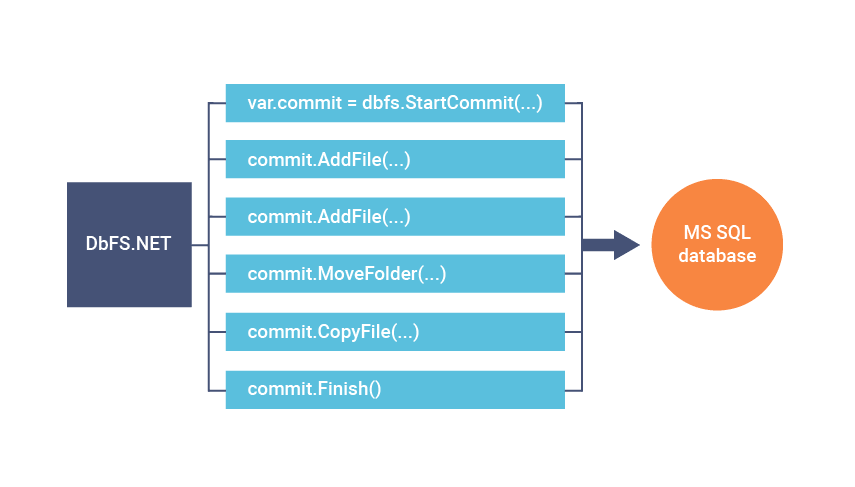Description
DbFS.NET is a high-level abstraction and implementation, which supports files (with versions and branches) in the MS SQL database.
For many enterprise-level purposes, we should keep everything in solid ACID storage and keep history for everything, including named BLOBs. DbFS.NET is based on the BLOBs in MS SQL. The approach is similar to version control systems, so with our solution, we provide the “native” way for programmers to manage unstructured contents.
1 var dbfs = new DBFS();
2 using (var commit = dbfs.StartCommit("Text", "admin", "Branch")) {
3 commit.AddFile(path, p => new
4 MemoryStream(Encoding.UTF8.GetBytes(content)));
5 commit.Finish();
6 }
1 var dbfs = new DBFS();
2 var list = dbfs.GetFilesList("Branch", "/folder/to/path/we/need").Select(e => e.Path);
Why DbFS.NET
DbFS.NET is a complete solution you can use in your applications immediately with EntityFramework model, database scripts, unit tests and even a command-line tool supporting bulk uploads and downloads of the content from the storage. Optionally, we have an ASP.NET MVC module for file maintenance visually.

Main Functions

DbFS.NET supports all typical operations that you might need:
- Branches (create, list, use, delete).
- Transactions (commit sets).
- Folders and Files.
- Full history: every change refers to a specific commit, and every file change (including addition or deletion) is tracked as a history change.
- Copy/Move file semantic without manual addition/removal.
- Database transactions automatic support.
- FILESTREAM support.
- Big files support (GB).
How DbFS.NET Works
DbFS.NET creates independent informational schema into your database and provides everything to work, including Files, Blobs, Branches, Commits, FileRevisions tables with all necessary indexes and stored procedures.
The underlying implementation is supported by EntityFramework models; so you just need to use the DbFS.NET service layer to manage all your data. If you need to go deeper, we have repositories for all underlying objects.

The database schema scripts are very simple and contain a database structure and initial contents (one branch named “Start” without files inside).
When you’re starting committing, all further operations are being collected into operations stack (with optimizations: if you add a file and then update it several times, the final data to commit will contain only one file with the real content, all intermediate changes won’t be accepted). The actual data will be updated in the database while the commit is being finished by Finish() call; the EF’ SaveChanges() method will be used automatically.
Download
We believe in freedom! This product is provided "AS IS" under the terms of the GNU GPL v3.
Setup, both 32 and 64 bit
You can also request any specific features you need — order our custom software development services, fast and cost-effective
Need a Similar Solution?
Related Products
.NET FontManager
With the help of .NET FontManager you can use the common type of font files, get contours of every glyph and draw them as you need.
GSpread.NET
GSpread.NET is a fast and easy to use library designed for working with Google Spreadsheets by using the well-known API from Microsoft Excel.
ASP.NET MVC Modules
Open source MVC framework for .NET to enable packing multiple resources, including views, icons, scripts, etc. in one DLL.